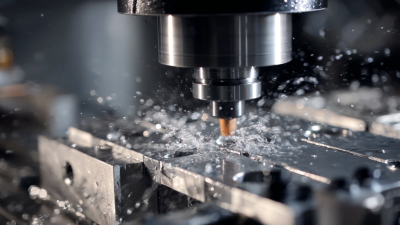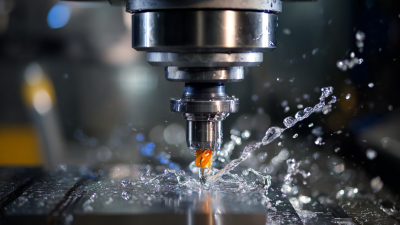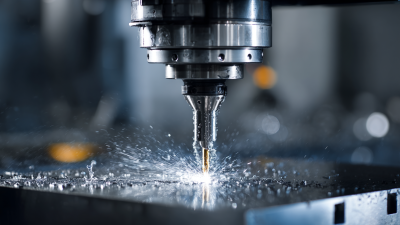
- sales@bjbod.com
- Mon - Sat at 7:00AM to 9:00PM

The 138th Canton Fair in 2025 promises to be a pivotal event for industries worldwide, especially in the realm of Metal CNC innovations. As the global manufacturing landscape continues to evolve, companies are increasingly seeking advanced technologies that enhance efficiency, precision, and sustainability. This fair serves as a significant platform for showcasing cutting-edge Metal CNC developments that are transforming production processes.

Attendees will have the opportunity to explore the latest machinery, software solutions, and industry trends that drive competitiveness in an ever-changing market. Furthermore, the insights garnered from this event will be invaluable for industry stakeholders aiming to adapt to technological advancements and customer demands. As we delve into the key innovations and insights presented at the fair, it becomes clear that the future of manufacturing heavily relies on the breakthroughs in Metal CNC technology, setting the stage for a new era of industrial excellence.
At the 138th Canton Fair 2025, groundbreaking advancements in metal CNC machinery took center stage, showcasing a wave of innovation that promises to revolutionize the manufacturing industry. Exhibitors spotlighted state-of-the-art technologies, including AI-driven automation and enhanced precision tools, which cater to the growing demand for efficiency and accuracy in metal fabrication. With a focus on sustainability, many companies presented eco-friendly solutions, emphasizing energy-efficient designs and reduced waste during the machining process.

In addition, live demonstrations of new CNC models highlighted their capabilities in complex part production, showcasing improvements in speed and flexibility. Experts discussed the integration of IoT (Internet of Things) technology, enabling real-time monitoring and analytics that empower manufacturers to optimize their workflows. These innovations not only address current industry challenges but also set the stage for future developments, underscoring the importance of adaptability in an ever-evolving market landscape. The enthusiasm around these advancements signals a promising direction for metal CNC machinery, positioning it as a crucial player in the global manufacturing arena.
Emerging trends in metal CNC technology highlight a significant evolution in the manufacturing landscape, driven by advancements in precision machining and automation. The global plasma cutting machine market is set to witness substantial growth, with projections estimating a rise from $699.5 million in 2025 to $905.2 million by 2032, reflecting a compound annual growth rate (CAGR) of 3.8%. This increase underscores the industry's adaptability to meet the demands of efficiency and precision in various production environments.
Additionally, the CNC vertical machining centers market is expected to grow by $1.09 billion from 2025 to 2029, fueled by the growing integration of AI technologies that enhance operational capabilities. The forecast for the precision turned product manufacturing market also indicates robust growth, with expectations of reaching USD 196.11 billion by 2034. Such trends indicate not only a thriving market but also an industry that is continuously evolving to incorporate innovative technologies that improve productivity and quality across manufacturing sectors.
The global demand for metal CNC solutions is expected to witness significant growth, driven by advancements in technology and an increasing focus on automation in manufacturing processes. With the CNC machine market projected to expand from $101.22 billion in 2025 to $195.59 billion by 2032, industries are looking for efficient and precise machinery that can streamline production and reduce operational costs. The rise in applications across various sectors, such as automotive, aerospace, and electronics, indicates a robust appetite for innovative machining solutions.
Moreover, the trend towards sustainable manufacturing practices is influencing the metal CNC market. Companies are increasingly investing in energy-efficient machines and eco-friendly technologies to meet regulatory standards and consumer demands. Insights from various market analyses highlight the importance of staying ahead in automation technology, with a forecasted CAGR of 9.9% for CNC machines, suggesting a clear trajectory toward more advanced and adaptable manufacturing methodologies in the coming years. As such, the exploration of metal CNC innovations at events like the 138th Canton Fair will be crucial for industry players aiming to navigate these evolving market dynamics.

The pursuit of greater efficiency and productivity in the manufacturing sector has led to significant innovations in metal CNC processes, particularly through the rise of automation. As companies strive to meet the increasing demand for precision and speed, CNC machines equipped with advanced automation technologies are proving to be indispensable. These machines not only streamline production workflows but also reduce operational costs, allowing manufacturers to remain competitive in a rapidly evolving market.
As observed at the 138th Canton Fair, the impact of automation on metal CNC processes is transforming the landscape of manufacturing. Automated CNC systems facilitate real-time monitoring and adjustments, minimizing errors and enhancing the quality of finished products. Moreover, with the integration of artificial intelligence and machine learning, these systems are becoming smarter, enabling predictive maintenance and optimizing production schedules. This technological advancement is expected to drive significant market growth, as businesses recognize the potential for improved output and decreased downtime, positioning them well for future challenges.
| Innovation Type | Impact on Efficiency (%) | Productivity Gain (units/hour) | Cost Reduction (%) | Implementation Time (months) |
|---|---|---|---|---|
| Advanced Automation Systems | 30% | 15 | 25% | 6 |
| AI-Driven Machining Solutions | 25% | 20 | 20% | 4 |
| Real-Time Monitoring Technologies | 20% | 18 | 15% | 5 |
| Integrated CAD/CAM Systems | 22% | 22 | 18% | 3 |
| Robotic Process Automation | 28% | 14 | 22% | 7 |
At the 138th Canton Fair in 2025, the focus on sustainable practices in metal CNC manufacturing is expected to gain significant traction. Recent reports indicate that the global CNC machine market is projected to reach $100 billion by 2026, with sustainability becoming a key driving force behind this growth. According to a study by MarketsandMarkets, about 40% of CNC manufacturers are adopting eco-friendly practices to reduce waste and energy consumption. This shift is not merely a trend but a necessity, as industries face increasing pressure from regulations and consumer demand for greener solutions.
Innovations in metal CNC technologies are aligning with sustainable goals, emphasizing energy efficiency and material optimization. Advanced machining techniques, such as additive manufacturing and hybrid machining, have emerged as pivotal in minimizing material waste. A report from McKinsey states that the implementation of these technologies can reduce material usage by up to 30% while also improving production speeds. As businesses seek to enhance their competitive edge, sustainable practices are becoming integral to operational strategies, ultimately leading to a more responsible and efficient manufacturing landscape.





